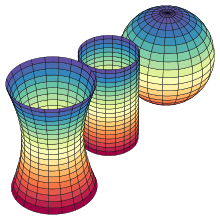
Back Curvatura gaussiana Catalan Gaußsche Krümmung German Curvatura de Gauss Spanish Täiskõverus Estonian Courbure de Gauss French עקמומיות גאוס HE Lengkungan Gauss ID Curvatura gaussiana Italian ガウス曲率 Japanese 가우스 곡률 Korean


In differential geometry, the Gaussian curvature or Gauss curvature Κ of a smooth surface in three-dimensional space at a point is the product of the principal curvatures, κ1 and κ2, at the given point:
The Gaussian radius of curvature is the reciprocal of Κ.
For example, a sphere of radius r has Gaussian curvature 1/r2 everywhere, and a flat plane and a cylinder have Gaussian curvature zero everywhere. The Gaussian curvature can also be negative, as in the case of a hyperboloid or the inside of a torus.
Gaussian curvature is an intrinsic measure of curvature, depending only on distances that are measured “within” or along the surface, not on the way it is isometrically embedded in Euclidean space. This is the content of the Theorema egregium.
Gaussian curvature is named after Carl Friedrich Gauss, who published the Theorema egregium in 1827.
© MMXXIII Rich X Search. We shall prevail. All rights reserved. Rich X Search
